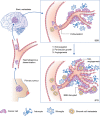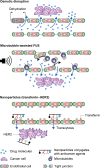Treatment strategies for breast cancer brain metastases
- PMID: 33250512
- PMCID: PMC7782834
- DOI: 10.1038/s41416-020-01175-y
Treatment strategies for breast cancer brain metastases
Abstract
Brain metastases from breast cancer (BCBM) constitute the second most common cause of brain metastasis (BM), and the incidence of these frequently lethal lesions is currently increasing, following better systemic treatment. Patients with ER-negative and HER2-positive metastatic breast cancer (BC) are the most likely to develop BM, but if this diagnosis remains associated with a worse prognosis, long survival is now common for patients with HER2-positive BC. BCBM represents a therapeutic challenge that needs a coordinated treatment strategy along international guidelines. Surgery has always to be considered when feasible. It is now well established that stereotaxic radiosurgery allows for equivalent control and less-cognitive toxicities than whole-brain radiation therapy, which should be delayed as much as possible. Medical treatment for BCBM is currently a rapidly evolving field. It has been shown that the blood-brain barrier (BBB) is often impaired in macroscopic BM, and several chemotherapy regimens, antibody-drug conjugates and tyrosine-kinase inhibitors have been shown to be active on BCBM and can be part of the global treatment strategy. This paper provides an overview of the therapeutic option for BCBM that is currently available and outlines potential new approaches for tackling these deadly secondary tumours.
Conflict of interest statement
C.B. and L.E. declare no conflict of interest. T.B. reports personal fees and non-financial support from Roche, grants, personal fees and non-financial support from Novartis, grants, personal fees and non-financial support from AstraZeneca, grants, personal fees and non-financial support from Pfizer, personal fees from SeattleGenetics, outside the submitted work.
Figures


References
-
- Quattrocchi CC, Errante Y, Gaudino C, Mallio CA, Giona A, Santini D, et al. Spatial brain distribution of intra-axial metastatic lesions in breast and lung cancer patients. J. Neurooncol. 2012;110:79–87. - PubMed
Publication types
MeSH terms
Substances
LinkOut - more resources
Full Text Sources
Medical
Research Materials
Miscellaneous

